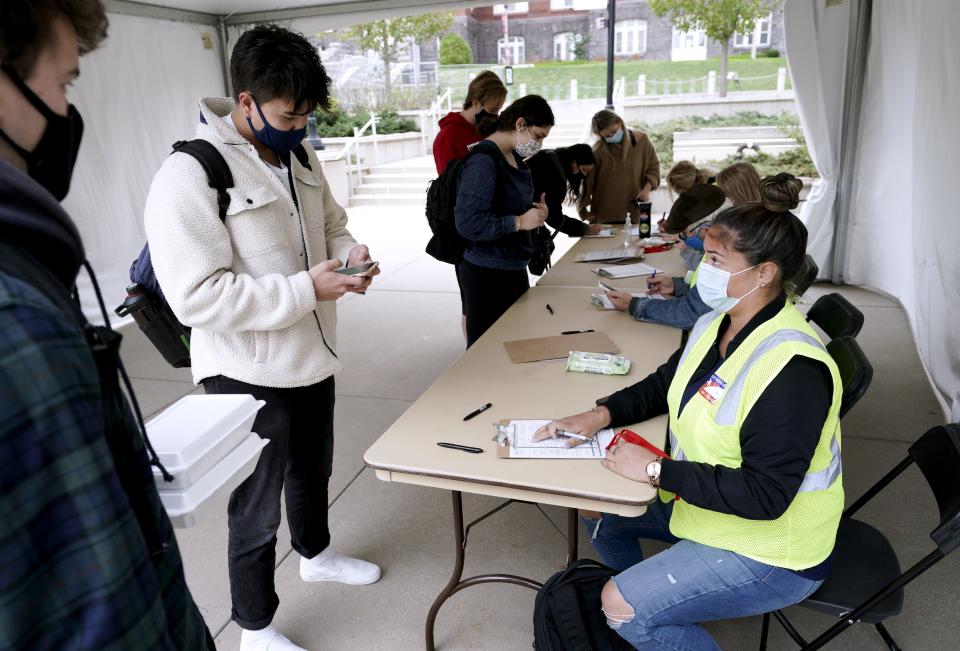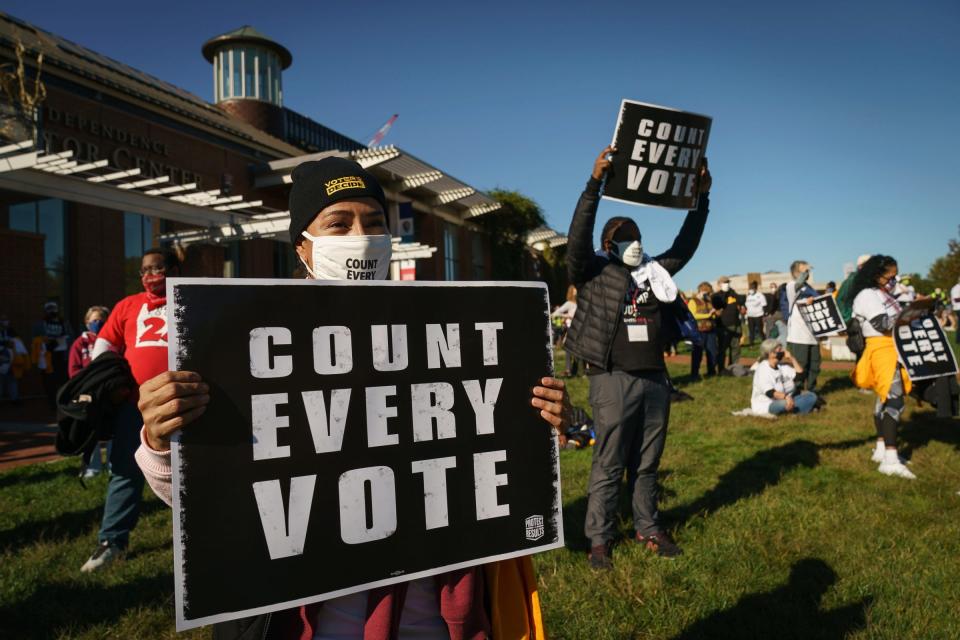Joe Biden flipped the 'blue wall' states of Michigan, Wisconsin and Pennsylvania, but work still needs to be done
Four years after Donald Trump broke through the Democratic “blue wall” of Michigan, Wisconsin and Pennsylvania, Joe Biden repaired the breach.
It was the overriding mission of his campaign, and it won him the presidency.
But it happened by slim margins and not entirely the way that Democrats drew it up. Four years ago, Trump won the three states by a combined 80,000 votes. This time, Biden's current tally has him up in the three states by more than 211,000 votes – a larger margin but not the decisive victories his campaign hoped to notch.
Which raises the question: Is the so-called blue wall really a “wall” anymore?
"We will continue to have to work it," said Democratic strategist Dee McBroom in Michigan.
"We're not California, we'll never be California," she said of the region’s competitiveness. "We'll never be New York."
On Saturday morning, she said, she was crying tears of joy over Biden's victory in Pennsylvania, which put him over the 270 Electoral College votes needed to win the presidency.
Rural-urban divide pronounced in Wisconsin
In Wisconsin, Democrats eked out a win without reversing either of Hillary Clinton’s most glaring electoral problems four years ago – a huge erosion of rural support and poor turnout in the state’s biggest city, Milwaukee, especially among African American voters.
"The results show we are still very much a battleground state," said Democratic U.S. Sen. Tammy Baldwin of Wisconsin, citing 2000, 2004, and 2016 presidential contests, all decided by under a point.

Turnout in Milwaukee got no better for Democrats this time. And 42 Wisconsin counties – many small, many rural – voted for Trump by even larger margins than before. Turnout spiked in many of these pro-Trump areas, amid the state’s soaring coronavirus caseload.
Related: Where Joe Biden won Wisconsin: Dane County and the Milwaukee County suburbs
Instead of solving his party’s problems with blue-collar and small-town voters, Biden was propelled by gains in the populous, high-education suburbs of Milwaukee and Madison.
Liberal communities outside Madison got bluer. Republican communities on the periphery of Milwaukee got less Republican. And some inner suburbs of Milwaukee that were purple in the George W. Bush and Barack Obama years voted overwhelmingly Democratic, reflecting population shifts and a backlash against Trump.
Among them was Wauwatosa, a place that Biden visited in August. It was decided by a single point in 2012. Eight years later, it voted Democratic by 34 points.
“I think the ship has sailed, and it sailed a while ago for Wauwatosa,” said the city’s Mayor Dennis McBride.
Trump grew base in Michigan despite loss
In Michigan, Trump surged in rural and older industrial areas. Statewide, he won about 365,000 more votes than he did four years ago, and he improved his margins across much of the state.
"(Trump) grew his base considerably. The pollsters were all wrong," said Susy Heintz Avery, a former Michigan Republican Party chairwoman and co-director of the Michigan Political Leadership Program at Michigan State University. "But what happened was the Democrats got their voters out ... it wasn't enough to overcome what they were able to get out in voter-rich southeastern Michigan."
Related: Here's how Biden beat Trump in Michigan — and it wasn't corruption
Biden exceeded Clinton’s vote by more than half a million statewide. That improvement did not come from the city of Detroit, where he got slightly fewer votes than Clinton.
But Biden outperformed Clinton in the rest of the Detroit metropolitan area and in some other key counties around the state – including Kent, home to Grand Rapids and a county Trump carried by three points in 2016.
"It would be a mistake for the Democrats to count on (these states) in 2024. It's still razor-thin, within 2 or 3 points,” said Peter Wielhouwer, a political science professor at Western Michigan University in Kalamazoo. “Biden was right not to take it for granted, and they shouldn't do so in the future."
Philly suburbs key for Biden in Pennsylvania
If anyone is curious about how Biden put Pennsylvania back into the win column for Democrats following 2016, pollster Terry Madonna said they shouldn't look any further than the Philadelphia suburbs.
In the four collar counties around the heavily Democratic city, Biden outperformed Clinton by more than 150,000 votes. And Biden kept adding counties along the Keystone State’s eastern border, forging Lehigh, Northampton, Monroe and Lackawanna counties into a miniature blue wall of sorts.

Related: How Trump lost Pennsylvania: Was he 'his own worst enemy' in race against Biden?
“He just outperformed Clinton in … significant ways in significant areas of the state,” said Madonna, director of the Center for Politics and Public Affairs at Franklin & Marshall College in Lancaster, Pennsylvania.
Biden also did better than expected in Allegheny County in southwestern Pennsylvania, receiving nearly 60% of the vote, and in Erie, the state’s northwestern corner, which he won by about 1 point after Trump took it by 1.5 points in 2016.
Election postmortems in Pennsylvania will show that even in counties Trump easily won, Biden was able to chip away at enough margins to capture the state.
Future of 'blue wall' uncertain
The shifts in these three battlegrounds were not nearly as large as the ones that scrambled the political map four years ago and delivered both the blue wall and the White House to Trump.
Only two counties changed hands last week in Wisconsin, three in Michigan and two in Pennsylvania.
Related: How Clinton lost 'blue wall' states of Mich., Pa., Wis.
Trump went from winning Pennsylvania by seven-tenths of a point in 2016 to losing it by seven-tenths of a point – a margin that could widen as votes continue to be tallied – in 2020. The president went from winning Michigan by two-tenths of a point in 2016 to losing it by three percentage points in 2020. And he went from winning Wisconsin by almost eight-tenths of a point in 2016 to losing it by six-tenths of a point in 2020 – a net vote shift of only about 43,000 votes.
Yet the takeaways from 2020 are striking.
For the second cycle in a row, Trump’s strength with the Rust Belt’s large pool of white blue-collar voters largely erased a longstanding Democratic advantage – and in a way that many polls failed to properly capture.
"It's clear we still have work to do in the rural parts of the state," said Baldwin, who performed well in many of those areas in her double-digit reelection victory in 2018. Baldwin said part of her success was showing up and spending time in rural Wisconsin, but the pandemic made it difficult for the Democratic ticket to do that in this campaign.
"I think the shifts we're seeing in the rural parts of the state are more permanent shifts toward the GOP," said Andrew Hitt, chairman of the Republican Party of Wisconsin.
He argued that Republican gains among rural voters would be more lasting than Democratic gains among suburban voters, saying many suburban voters "did not connect with the president," and were reacting more to his personality than policies.
Democratic pollster Paul Maslin said that despite Biden’s victory, the voting patterns are sobering for his party, especially when looking ahead to the 2022 midterms. That’s when Democrats need to defend a narrow U.S. House majority and multiple governor seats.
“This is still dangerous territory,” said Maslin.
Last week was a vivid reminder that both parties have suffered serious defections and face lingering vulnerabilities in these states – the suburbs for Republicans, the countryside for Democrats.
And it was a reminder of the widening demographic fault lines in these states, including education, religion and geography.
Unanswered for now is what all these trends and cross currents will look like when Trump is no longer on the ballot.
Ben Wikler, the Wisconsin Democratic chair, said his party’s supporters need to understand their state is “balanced on the tip of a needle, and that only constant organizing and vigilance will keep it moving in the right direction."
While voters in the suburbs are trending Democratic for now, voters in areas that have seen huge manufacturing losses and depopulation are trending more Republican and could continue to do so.
Former Michigan Gov. Jim Blanchard, who is an adviser and friend to Biden, said Biden's wins in the three states indicate the blue wall is back and could remain so in the future.
"But it takes hard work. The chattering classes in Georgetown somehow believed Michigan was automatic. They've never understood that we're a toss-up state," he said. "We're a classic toss-up state. So is Wisconsin. Now, I think, so is Pennsylvania. With hard work and the right candidate, we can do this again, but never take it for granted."
Follow Craig Gilbert, Todd Spangler and J.D. Prose on Twitter: @WisVoter, @tsspangler, @jdprose
This article originally appeared on USA TODAY: 'Blue wall': How Joe Biden flipped Michigan, Wisconsin, Pennsylvania
